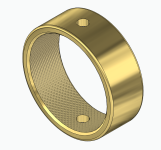Blough
Aluminum
- Joined
- Aug 19, 2017
- Location
- Akron-Canton
This part we make is intended to be press-fit over a plastic tube, the ID is knurled.
We have been having issues with tolerancing, and I have been assigned to review the part and make sure it was designed correctly.

First thing is to familiarize myself with the knurling process.
Since it is a process of displacing material instead of removing it, the tolerances of the blank are a lot more important.
I see that there are relevant standards that guide the design of blanks to be knurled such as ANSI/ASME B94.6-1984 (2014)
But I've noticed the standard only refers to outside knurls. Are the tolerance classes interchangeable with internal knurls as well?
(Also I want to make a note that I do not believe there is any advantage to knurling on this part, it gets fitted on a turned piece of G10 laminate and pinned with the thru hole. But "Thats how we have always done it")
We have been having issues with tolerancing, and I have been assigned to review the part and make sure it was designed correctly.

First thing is to familiarize myself with the knurling process.
Since it is a process of displacing material instead of removing it, the tolerances of the blank are a lot more important.
I see that there are relevant standards that guide the design of blanks to be knurled such as ANSI/ASME B94.6-1984 (2014)
But I've noticed the standard only refers to outside knurls. Are the tolerance classes interchangeable with internal knurls as well?
(Also I want to make a note that I do not believe there is any advantage to knurling on this part, it gets fitted on a turned piece of G10 laminate and pinned with the thru hole. But "Thats how we have always done it")

